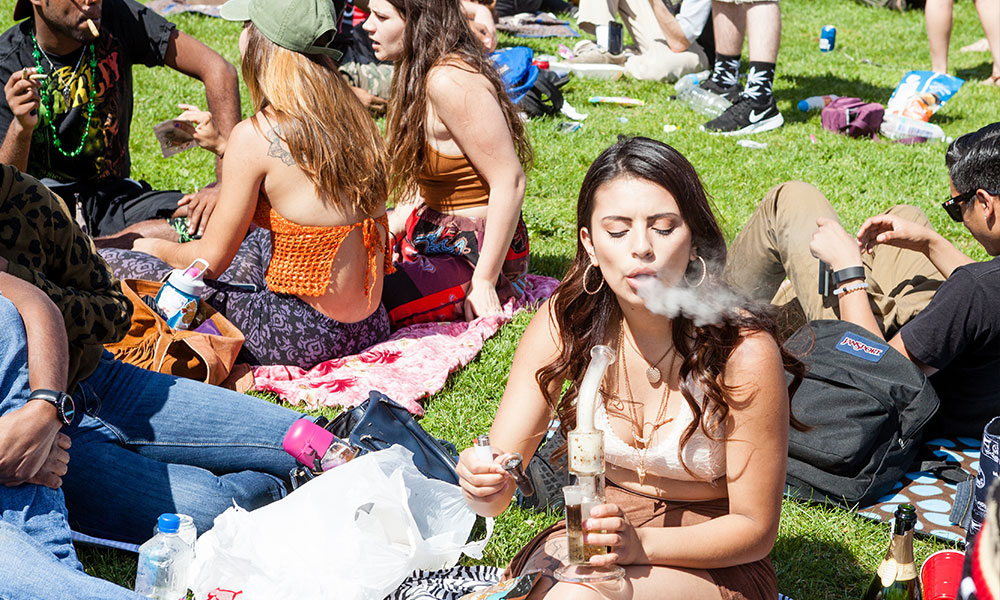
Culture
Marijuana Use Among College-Aged People at 30-Year High
Thirty-eight percent of full-time college students and a record-breaking 41 percent of college-aged Americans now admit to using marijuana.
College is where a lot of America’s youth go to experience excess for the first time. It is part of that soul-searching process that nearly everyone takes shortly after coming of age, in which a person ventures into territories that will inevitably determine whether they spend their first year of academia slumped over a toilet in a blackout stupor or if they’ll make it to class without a throbbing hangover.
In the case of the latter, these are the students who learn right out of the gate that marijuana is more advantageous to maintaining a hectic school schedule than trying to climb out of the bottom of the bottle every morning. It can be a harsh lesson for some. Fortunately, a new study from the University of Michigan finds that more college kids are smoking marijuana these days than they have in the past three decades.
In the latest Monitoring the Future survey — a federal study funded by the National Institute on Drug Abuse, researchers found that recreational pot consumption among young adults between the ages of 19 and 22 seems to have ramped up over the past decade. Now, 38 percent of full-time college students admit to using marijuana. In 2006, that number was only 30 percent.
According to the survey’s results, the number of college students smoking cannabis was actually slightly higher in 2016.
The record-breaking, 30-year-high percentages are coming from the kids who opted not to attend college.
The study found that people aged 19 to 22 who didn’t move on to further their education after high school were more likely to use marijuana, as well. Forty-one percent admitted to getting high at least once over the course of a year. Researchers believe this can be attributed to the evolution of pot laws in the United States, changing attitudes and the fact that “people are not perceiving use, even regular use, as dangerous as they used to.”
Not since 1987 has the study uncovered such a stoned college-aged community. That was a time that some of us remember well. We were on the verge of becoming teenagers and we may or may not have witnessed weed being passed around for the first time during a Motley Crue concert. It would appear that history is repeating itself to some degree. Sure, the Crue has since stopped touring, but researchers say pot consumption numbers among college-aged Americans have finally come back around.
This has researchers concerned.
“The continued increase of daily marijuana use among non-college youth is especially worrisome,” John Schulenberg, lead researcher of the Monitoring the Future study, said in a statement. “The brain is still growing in the early 20s, and the scientific evidence indicates that heavy marijuana use can be detrimental to cognitive functioning and mental health.”
But contrary to the negative headlines that will likely emerge from this study, this increase in marijuana consumption is not necessarily a sign of an impending apocalypse. There is more evidence to suggest that alcohol and prescription opioids are a gateway to harder drugs than marijuana.
And addiction rates connected to the herb are minuscule, at best — comparable to caffeine. This means the majority of this demographic will never experience any real detriment as result of their pot consumption, said Sheila Vakharia, policy manager for the Drug Policy Alliance.
“There’s a difference between trying and experimenting, and actually having a problem,” she told Detroit News. “We don’t know if these people are smoking weed and then missing class, slacking on assignments and if starting on marijuana has impacted relationships with family and friends.”
Perhaps the most important takeaway from the study is young people are still using fewer hard drugs, like prescription painkillers and ecstasy. These numbers have been on the decline for the past several years. Even binge drinking is experiencing a steady decay. There is evidence that legal marijuana in some parts of the country may be helping.
TELL US, when did you start smoking cannabis?

























